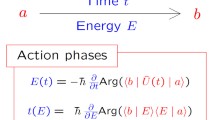Abstract
The Schrödinger equation for a macroscopic number of particles is linear in the wave function, deterministic, and invariant under time reversal. In contrast, the concepts used and calculations done in statistical physics and condensed matter physics involve stochasticity, nonlinearities, irreversibility, top-down effects, and elements from classical physics. This paper analyzes several methods used in condensed matter physics and statistical physics and explains how they are in fundamental ways incompatible with the above properties of the Schrödinger equation. The problems posed by reconciling these approaches to unitary quantum mechanics are of a similar type as the quantum measurement problem. This paper, therefore, argues that rather than aiming at reconciling these contrasts one should use them to identify the limits of quantum mechanics. The thermal wavelength and thermal time indicate where these limits are for (quasi-)particles that constitute the thermal degrees of freedom.
Similar content being viewed by others
References
Adler, S.L.: Why decoherence has not solved the measurement problem: a response to P.W. Anderson. Stud. Hist. Philos. Sci. Part B Stud. Hist. Philos. Mod. Phys. 34(1), 135–142 (2003)
Ballentine, L.E.: The statistical interpretation of quantum mechanics. Rev. Mod. Phys. 42, 358–381 (1970)
Bassi, A., Lochan, K., Satin, S., Singh, T.P., Ulbricht, H.: Models of wave-function collapse, underlying theories, and experimental tests. Rev. Mod. Phys. 85(2), 471 (2013)
Breuer, H.-P., Petruccione, F.: The Theory of Open Quantum Systems. Oxford University Press on Demand, Oxford (2002)
Chibbaro, S., Rondoni, L., Vulpiani, A.: Reductionism, Emergence and Levels of Reality, Ch. 6. Springer, Berlin (2014)
Deutsch, J.M.: Quantum statistical mechanics in a closed system. Phys. Rev. A 43(4), 2046 (1991)
Drossel, B.: Connecting the quantum and classical worlds. Annalen der Physik 529(3), 1600256 (2017)
Drossel, B.: Ten reasons why a thermalized system cannot be described by a many-particle wave function. Stud. Hist. Philos. Sci. Part B Stud. Hist. Philos. Mod. Phys. 58, 12–21 (2017)
Drossel, B., Ellis, G.: Contextual wavefunction collapse: an integrated theory of quantum measurement. New J. Phys. 20(11), 113025 (2018)
Eisert, J., Friesdorf, M., Gogolin, C.: Quantum many-body systems out of equilibrium. Nat. Phys. 11(2), 124–130 (2015)
Ellis, G.: How Can Physics Underlie the Mind? Top-down Causation in the Human Context. Springer, Heidelberg (2016)
Ellis, G.F.R.: On the limits of quantum theory: contextuality and the quantum-classical cut. Ann. Phys. 327(7), 1890–1932 (2012)
Hugh Everett, I.I.I.: “Relative state” formulation of quantum mechanics. Rev. Mod. Phys. 29(3), 454 (1957)
Fuchs, C.A.: Qbism, the perimeter of quantum Bayesianism. arXiv preprint arXiv:1003.5209 (2010)
Gisin, N.: Collapse. What else? In: Gao, S. (ed.) Collapse of the Wave Function: Models, Ontology, Origin, and Implications, pp. 207–224. Cambridge University Press, Cambridge (2018)
Gisin, N.: Indeterminism in physics, classical Chaos and Bohmian mechanics. Are real numbers really real? arXiv preprint arXiv:1803.06824 (2018)
Gogolin, C., Eisert, J.: Equilibration, thermalisation, and the emergence of statistical mechanics in closed quantum systems. Rep. Prog. Phys. 79(5), 056001 (2016)
Grabowski, P.E.: A review of wave packet molecular dynamics. In: Frontiers and Challenges in Warm Dense Matter, pp. 265–282. Springer, Berlin (2014)
Grangier, P., Auffèves, A.: What is quantum in quantum randomness? Philos. Trans. R. Soc. A Math. Phys. Eng. Sci. 376(2123), 20170322 (2018)
Griffiths, R.B.: Consistent histories and the interpretation of quantum mechanics. J. Stat. Phys. 36(1–2), 219–272 (1984)
Hollowood, T.J.: Decoherence, discord, and the quantum master equation for cosmological perturbations. Phys. Rev. D 95(10), 103521 (2017)
Jaynes, E.T.: Information theory and statistical mechanics. Phys. Rev. 106(4), 620 (1957)
Kittel, C., Kroemer, H.: Thermal Physics. Macmillan, London (1980)
Walter Kohn and Lu Jeu Sham: Self-consistent equations including exchange and correlation effects. Phys. Rev. 140(4A), A1133 (1965)
Landau, L.D., Lifshitz, E.M.: Course of Theoretical Physics. Elsevier, Amsterdam (2013)
Laughlin, R.B., Pines, D.: The theory of everything. In: Proceedings of the national academy of sciences of the United States of America, pp. 28–31 (2000)
Leggett, A.J.: On the nature of research in condensed-state physics. Found. Phys. 22(2), 221–233 (1992)
Marx, D., Hutter, J.: Ab initio molecular dynamics: theory and implementation. Mod. Methods Algorithms Quantum Chem. 1, 301–449 (2000)
Matyus, E.: Pre-born-oppenheimer molecular structure theory. arXiv preprint arXiv:1801.05885 (2018)
Popescu, S., Short, A.J., Winter, A.: Entanglement and the foundations of statistical mechanics. Nat. Phys. 2(11), 754–758 (2006)
Primas, H.: Chemistry, Quantum Mechanics and Reductionism: Perspectives in Theoretical Chemistry, vol. 24. Springer, Heidelberg (2013)
Reimann, P., Evstigneev, M.: Quantum versus classical foundation of statistical mechanics under experimentally realistic conditions. Phys. Rev. E 88(5), 052114 (2013)
Rovelli, C.: Relational quantum mechanics. Int. J. Theor. Phys. 35(8), 1637–1678 (1996)
Rovelli, C.: Space is blue and birds fly through it. Philos. Trans. R. Soc. A 376, 2017.0312 (2018)
Schlosshauer, M.: Decoherence, the measurement problem, and interpretations of quantum mechanics. Rev. Mod. Phys. 76(4), 1267 (2005)
Schwabl, F.: Advanced quantum mechanics. Springer, Berlin, Heidelberg (2005)
Schwabl, F., Brewer, W.D.: Statistical Mechanics. Advanced Texts in Physics. Springer, Berlin (2006)
Schwabl, F.: Quantum mechanics. Springer, Berlin, Heidelberg (2007)
Srednicki, M.: Chaos and quantum thermalization. Phys. Rev. E 50(2), 888 (1994)
Tuckerman, M.E., Martyna, G.J.: Understanding modern molecular dynamics: techniques and applications. J. Phys. Chem. B 104(2), 159–178 (2000)
Weiss, U.: Quantum Dissipative Systems, vol. 13. World Scientific, Singapore (2012)
Wojciech Hubert Zurek: Decoherence, einselection, and the quantum origins of the classical. Rev. Mod. Phys. 75(3), 715 (2003)
Author information
Authors and Affiliations
Corresponding author
Additional information
Publisher's Note
Springer Nature remains neutral with regard to jurisdictional claims in published maps and institutional affiliations.
Rights and permissions
About this article
Cite this article
Drossel, B. What condensed matter physics and statistical physics teach us about the limits of unitary time evolution. Quantum Stud.: Math. Found. 7, 217–231 (2020). https://doi.org/10.1007/s40509-019-00208-3
Received:
Accepted:
Published:
Issue Date:
DOI: https://doi.org/10.1007/s40509-019-00208-3




